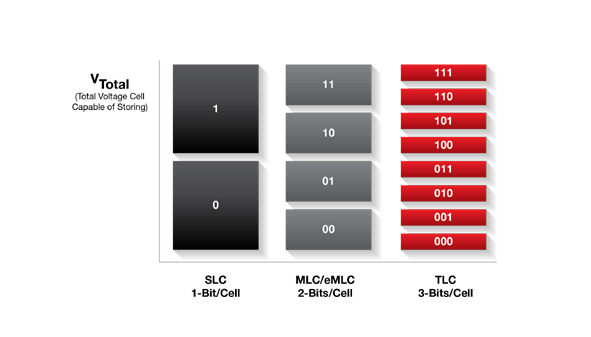Back in 2009, an SSD controller start-up I used to work for began to tout MLC in enterprise. It was a shocking departure from the conventional wisdom of the time that enterprise SSDs needed to support 25 DWPD (Drive Writes Per Day) which only SLC flash could support. Additionally at the time people had some unfounded concerns that the reliability of any flash but SLC would be unacceptable in an always-on, 5-year lifecycle, critical infrastructure environment. To support the effort, a number of flash companies—Toshiba included—introduced “eMLC”, a new type of enterprise-grade flash with higher endurance ratings than MLC and better economics than SLC, as well as larger die stacks (eight at the time) to support the vision that MLC could replace SLC in enterprise SSDs, and to enable higher capacity and lower cost SSDs.

Even with MLC buzz everywhere (including enterprise and data centers) and MLC-based client SSD quickly becoming ubiquitous, there were many doubters. In a Flash Memory Summit keynote that year, one company executive even said, “No one will ever use MLC in enterprise SSDs”. Boy were they wrong.

In 2017, MLC is expected to be 53%1 of SSD shipments into enterprise and we are already beginning to see the adoption of TLC flash in enterprise and data center SSDs utilizing 3D flash technologies. This is a freight train with no brakes!
But “TLC in enterprise” you ask? Never say never. Now flash vendors are introducing enterprise TLC or “eTLC” on their 3D nodes. As more vendors introduce SSD offerings based on this 3D TLC flash memory, the shift towards these lower cost solutions is inevitable and driven by a few factors:
- Larger SSD capacities
16TB SSDs are in production with 32TB SSDs hot on their heels2. When your SSD is that large, the number of times you need to write to it daily is significantly reduced.
- Better understanding of workloads
After years of SSD usage, users have seen that drives are typically written to much less than once per day, so the fear of flash wear-out due to lesser endurance is significantly reduced. And the old reliability concerns are alleviated. FUD always loses in the end even if it is successful at delaying progress for a time.
- Improved system usage
Systems have adapted their software to handle SSDs more efficiently. Just as systems altered their access patterns to minimize seek latencies on HDDs, vendors have now altered their systems to use advanced features like write linearization and streams to maximize SSD endurance.
Furthermore, TLC 3D flash read latencies are now closer to parity with MLC 2D flash read latencies. And for those users who want the absolutely fastest read latencies, SLC flash is emerging as the option of choice, while MLC just sits in the middle; not the cheapest, not the fastest…
So, at least in the context of mainstream client, cloud, datacenter and enterprise SSDs, what is MLC good for anyway? In the words of Edwin Starr, “Absolutely Nothing – Say it again!”
1 Forward Insights SSD Insights Q2/17 Report FI-NFL-SSD-Q2 17 May 2017
2 Definition of capacity: Toshiba defines a terabyte (TB) as 1,000,000,000,000 bytes. A computer operating system, however, reports storage capacity using powers of 2 for the definition of 1GB = 230 = 1,073,741,824 bytes and therefore shows less storage capacity. Actual formatted capacity may vary.
Disclaimer
The views and opinions expressed in this blog are those of the author(s) and do not necessarily reflect those of KIOXIA America, Inc.